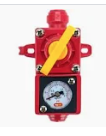Hi all. I plan on kegging a double batch I brewed about a month ago. Currently it's at 15psi at 64F. In the past, I've just bled off the pressure of the fermenter before transfer and pushed it to my serving keg at 2psi.
My thoughts are to connect a jumper gas post to gas post from fermenter to keg so the pressure equalizes between the two vessels. Then what? Connect a jumper from beer post to beer post and bleed off the keg's pressure via the prv? I've read here transferring too fast will produce foaming. If both vessels are at equal pressure, then do you use the prv valve of the keg or disconnect the gas jumper and just put a spunding valve on the keg (nothing on the fermenter) to do a slow transfer?
On another note, is there a way to see how much more days on gas a pressurized fermentation needs after transferring to a serving keg? As mentioned, it's at 15psi at 64F. If I can keg this batch tonight, how much time do I need on gas to drink it this weekend? Thanks in advance.
My thoughts are to connect a jumper gas post to gas post from fermenter to keg so the pressure equalizes between the two vessels. Then what? Connect a jumper from beer post to beer post and bleed off the keg's pressure via the prv? I've read here transferring too fast will produce foaming. If both vessels are at equal pressure, then do you use the prv valve of the keg or disconnect the gas jumper and just put a spunding valve on the keg (nothing on the fermenter) to do a slow transfer?
On another note, is there a way to see how much more days on gas a pressurized fermentation needs after transferring to a serving keg? As mentioned, it's at 15psi at 64F. If I can keg this batch tonight, how much time do I need on gas to drink it this weekend? Thanks in advance.


















![Craft A Brew - Safale S-04 Dry Yeast - Fermentis - English Ale Dry Yeast - For English and American Ales and Hard Apple Ciders - Ingredients for Home Brewing - Beer Making Supplies - [1 Pack]](https://m.media-amazon.com/images/I/41fVGNh6JfL._SL500_.jpg)









































